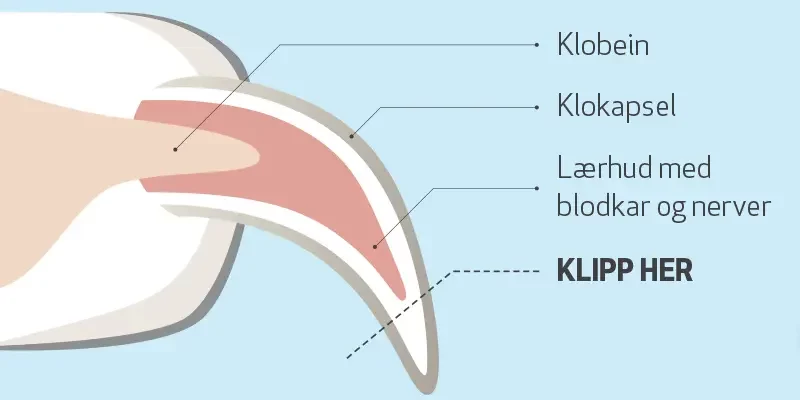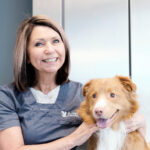Does the dog need sedation before claw trimming?
How to Trim Dog Claws: A Guide to Proper Claw Trimming
Not all dogs appreciate having their claws clipped. Claw trimming is an important part of dog grooming to maintain the dog's general well-being. Claws that grow too long can cause discomfort and even health problems for your dog. It is therefore important to know how to cut claws correctly. If the dog is very stressed, declawing with sedative at the vet be the best solution. This article will provide you with useful information about bell clipping in dogs and give you some tips to make the process easier.
Table of contents
Why use sedatives for claw clipping in dogs?
For most dogs, clipping their claws is completely undramatic, but some find it terribly scary. This may be because they have had a bad experience in the past, or they are simply not used to it.
It is important that the dog does not experience claw clipping as traumatic or stressful. If the dog is perceived as nervous or aggressive, it is a clear sign that the situation is perceived as unsafe. In cases of particularly fearful dogs, it may be necessary to use sedatives so that a vet can cut the claws while the dog sleeps.
Why is bell clipping important?
Your dog's claws will naturally wear down through activity and walking on different surfaces. However, some dogs may have claws that grow faster than they wear down, especially if they spend a lot of time indoors or on soft surfaces. Long claws can be problematic for the dog in several ways:
Pain and discomfort: Long claws can begin to curl and grow into the pads of your dog's paws. This can lead to pain, discomfort and even infections.
Problems with walking: Claws that are too long can lead to altered walking and imbalance in the dog. This in turn can affect joints and muscles, and increase the risk of injury.
Injuries and bleeding: If the claws get too long, they can easily break or chip, which can lead to bleeding and infections.
When should you cut the claws?
The frequency of bell clipping in dog varies. Generally speaking, you should trim the claws when they begin to approach the length where they touch the ground when the dog walks. For some dogs this may be every month, while for others it may be less frequent. Keep an eye on the length of the claws and be aware of any signs of discomfort or trouble when the dog is walking.

How to cut your dog's claws?
Clipping your dog's claws can seem intimidating at first, but with a little practice and patience, you can make it a stress-free experience for both you and your dog. Follow these steps to trim the claws properly:
Get the right equipment: You need good claw scissors or claw pliers that are suitable for dog claws. Talk to your vet or a professional groomer for recommendations on which equipment is best for your dog.
Be prepared: Keep a blood-stopping powder or gel handy in case you cut too far and the claws start to bleed. This will help to stop the bleeding quickly.
Get your dog used to being touched: Before you start clipping the claws, spend some time getting your dog used to having his paws touched. Enjoy and provide positive experiences while handling the paws gently.
Identify the claws: The dog usually has a claw on each toe, as well as one on the inside of the front legs if it has one. Identify which claws need clipping.
Cut gently: Hold the paw gently but firmly and use the claw scissors or claw pliers to cut off the outer tip of the claws. Be careful not to cut too far and cut into the living part of the claws. Rather cut a little and often, rather than risk cutting too far.
Praise and reward: After each successful clip, praise and reward your dog with treats or positive reinforcement. This will help the dog to associate clock clipping with something positive.
How much does dog grooming cost?
Claw trimming is an important part of dog grooming to maintain your dog's health and well-being. By learning how to trim nails properly and following the steps mentioned above, you can make nail trimming a positive experience for both you and your dog. Remember to be patient, take it gradually and seek professional help if you feel unsure.
Claw trimming is not always easy. At A-Vet, we can help you with the regular claw clipping, as well as give you advice and guidance on how you can try it yourself at home next time.
Elisabeth is a veterinarian and authorized ophthalmologist with specialization in eye surgery, as well as further training in internal medicine, general surgery, oral surgery and ultrasound from the European School for Advanced Veterinary Studies in Toulouse.
-
Elisabeth Bjørnestadhttps://www.a-vet.no/author/elisabeth_bjornestad/
-
Elisabeth Bjørnestadhttps://www.a-vet.no/author/elisabeth_bjornestad/
-
Elisabeth Bjørnestadhttps://www.a-vet.no/author/elisabeth_bjornestad/
-
Elisabeth Bjørnestadhttps://www.a-vet.no/author/elisabeth_bjornestad/


